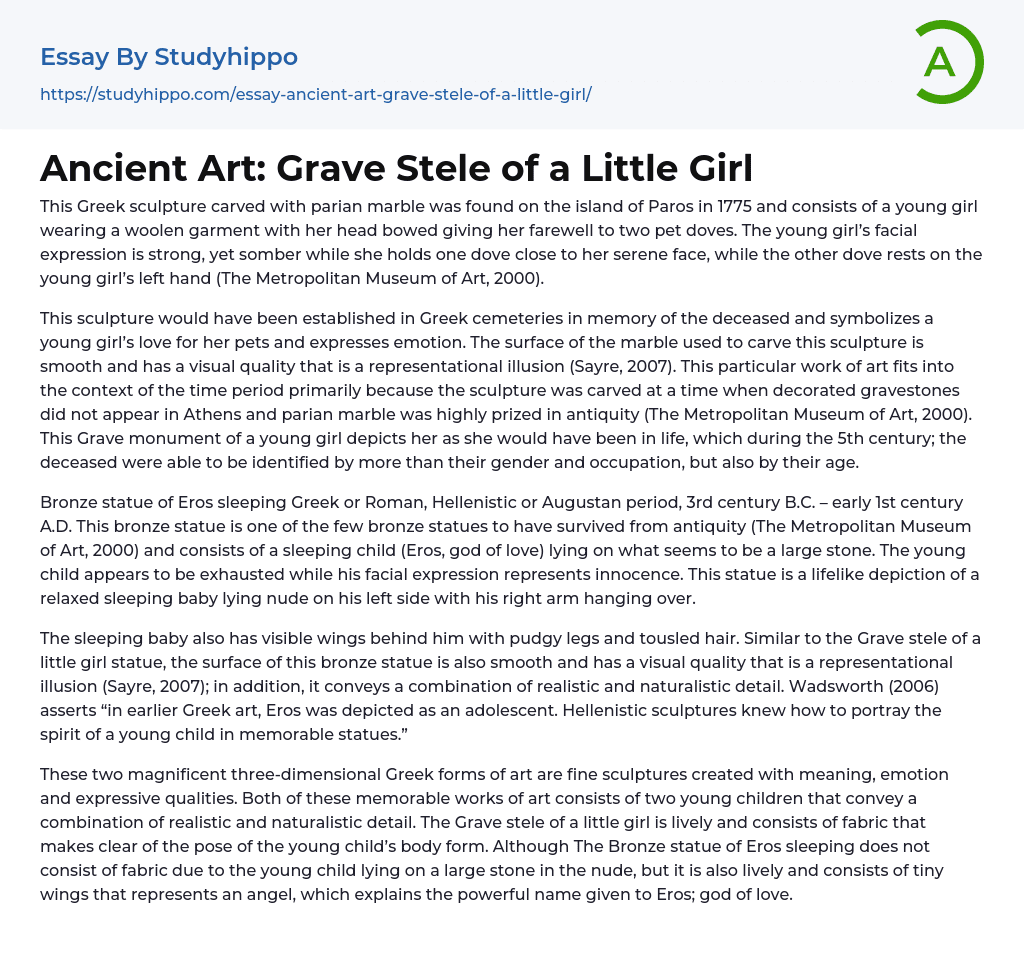This Greek sculpture carved with parian marble was found on the island of Paros in 1775 and consists of a young girl wearing a woolen garment with her head bowed giving her farewell to two pet doves. The young girl’s facial expression is strong, yet somber while she holds one dove close to her serene face, while the other dove rests on the young girl’s left hand (The Metropolitan Museum of Art, 2000).
This sculpture would have been established in Greek cemeteries in memory of the deceased and symbolizes a young girl’s love for her pets and expresses emotion. The surface of the marble used to carve this sculpture is smooth and has a visual quality that is a representational illusion (Sayre, 2007). This particular work of art fits into the context of the time period primarily
...because the sculpture was carved at a time when decorated gravestones did not appear in Athens and parian marble was highly prized in antiquity (The Metropolitan Museum of Art, 2000). This Grave monument of a young girl depicts her as she would have been in life, which during the 5th century; the deceased were able to be identified by more than their gender and occupation, but also by their age.
Bronze statue of Eros sleeping Greek or Roman, Hellenistic or Augustan period, 3rd century B.C. – early 1st century A.D. This bronze statue is one of the few bronze statues to have survived from antiquity (The Metropolitan Museum of Art, 2000) and consists of a sleeping child (Eros, god of love) lying on what seems to be a large stone. The young child appears to be exhausted while his facia
expression represents innocence. This statue is a lifelike depiction of a relaxed sleeping baby lying nude on his left side with his right arm hanging over.
The sleeping baby also has visible wings behind him with pudgy legs and tousled hair. Similar to the Grave stele of a little girl statue, the surface of this bronze statue is also smooth and has a visual quality that is a representational illusion (Sayre, 2007); in addition, it conveys a combination of realistic and naturalistic detail. Wadsworth (2006) asserts “in earlier Greek art, Eros was depicted as an adolescent. Hellenistic sculptures knew how to portray the spirit of a young child in memorable statues.”
These two magnificent three-dimensional Greek forms of art are fine sculptures created with meaning, emotion and expressive qualities. Both of these memorable works of art consists of two young children that convey a combination of realistic and naturalistic detail. The Grave stele of a little girl is lively and consists of fabric that makes clear of the pose of the young child’s body form. Although The Bronze statue of Eros sleeping does not consist of fabric due to the young child lying on a large stone in the nude, but it is also lively and consists of tiny wings that represents an angel, which explains the powerful name given to Eros; god of love.
- Boy essays
- Gay essays
- Gender essays
- Gender Identity essays
- Gender Roles In Society essays
- Gender Stereotypes essays
- Girl essays
- Homosexuality essays
- Human Sexual Behavior essays
- Lgbt essays
- Man essays
- Masculinity essays
- Sexual Orientation essays
- Transgender essays
- Woman essays
- Architecture essays
- Design essays
- Graffiti essays
- Graphic essays
- Interior design essays
- Painting essays
- Photography essays
- Sculpture essays
- Typography essays




